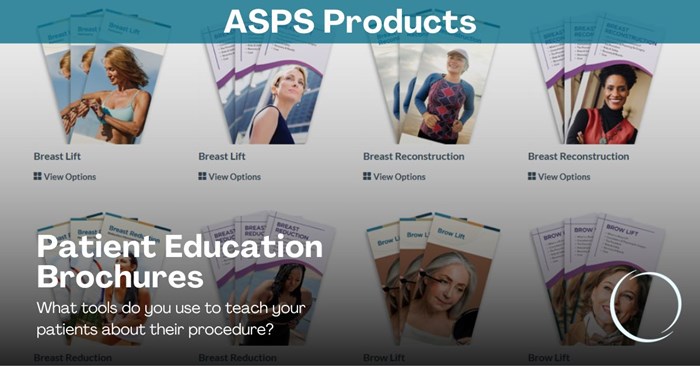New brochures boost Society's patient-education efforts

With prospective plastic surgery patients subject to wide-ranging information – and disinformation – about procedures online, on social media channels and across all media, it can be overwhelming for patients to not only find the appropriate plastic surgeon but to understand the complexity of the procedure itself. ASPS is working to make that education a little easier.
"The Public Education Committee felt as though the patient-brochure line was in need of an upgrade, since the original brochures were designed a long time ago," notes ASPS Public Education Committee Chair Josef Hadeed, MD, Beverly Hills, Calif. "We felt the content needed to be updated – and that the layout, illustrations and photos within the brochures needed to be modernized. We wanted to produce a brochure line that all ASPS members could utilize in their practices."
The overhaul of the brochures was a years-long process that necessitated collaboration between the ASPS Patient Education Committee, Society staff and consultants. It began with overhauling the content surrounding breast augmentation, which fortified the brochures' two lines,
"Transformation" and "Passionate." Each line differs in its aesthetics, with unique covers and color palettes that allow surgeons to choose the look that best suits their practice – while maintaining the same high-quality content.
The updated brochures feature:
- Modernized layouts with refreshed colors and typography that create a cohesive and professional aesthetic
- Updated medical illustrations that offer a more accurate and comprehensive representation of the procedures and treatments
- Detailed information about procedures, risks and benefits and postoperative care
- Inclusion of a more diverse representation of patient models, promoting inclusivity and diversity for the modern practice
In designing the new brochures, ASPS staff sourced more than 150 photos and contracted with a specialized medical illustrator to provide dozens of medical illustrations. These images were reviewed and those selected were utilized to specifically enhance patients' understanding of complex medical concepts and procedures – and also to give a stronger sense of real people going through the plastic surgery journey.
"Patients should see themselves in the brochures," says Public Education Committee Vice Chair Michele Shermak, MD, Lutherville-Timonium, Md. "The text has been updated and the illustrations should be more useful for the physician consultant to aid in surgical planning and patient understanding."
The committee got its first look at options for the refreshed brochures at Plastic Surgery The Meeting last year in Boston, providing positive feedback to the Society's marketing team. Beyond just an aesthetic upgrade, however, the committee worked with ASPS staff to update the content within the brochures, assessing the previous iterations and identifying areas for improvement. The team not only conducted research on the latest trends in patient-education materials, but also solicited feedback from peers, healthcare providers and other stakeholders.
"The new brochures removed a lot of excess information – and the updated layout is sleeker," Dr. Hadeed tells PSN. "The text within the brochure has also been simplified in order to appeal to a wider range of patients. Content includes the most relevant and current information regarding procedures – and the illustrations now more accurately depict the actual procedures."
The doctors note although patients do much of their research about plastic surgery online, many of those who visit a practice still want to take something physical home with them as a reminder of what the surgeon told them in their consultation. The refreshed brochures both remind the patient of the points discussed and underscore the importance of choosing that ASPS member for their procedure.
The first wave of brochures launched this spring, with samples being provided with the April/May edition of PSN. Early feedback has been extremely positive. ASPS is also using the medical illustrations from the brochures to enhance the procedural pages on plasticsurgery.org, in concert with members reviewing the medical content of the brochures to refresh the copy on the website's procedure pages – all while maintaining the SEO initiatives the Society has pursued in recent years.
The updated brochures are now live and available for purchase online at ShopASPS.org, where you can also preview each brochure in the Patient Education area.
"For those of us who use the brochures to educate patients, there's a more substantial education benefit with the new line," Dr. Shermak says. "We expect that the updated brochures will improve patient education, increase patient engagement and ultimately result in better outcomes. I know I'm excited to start using them."